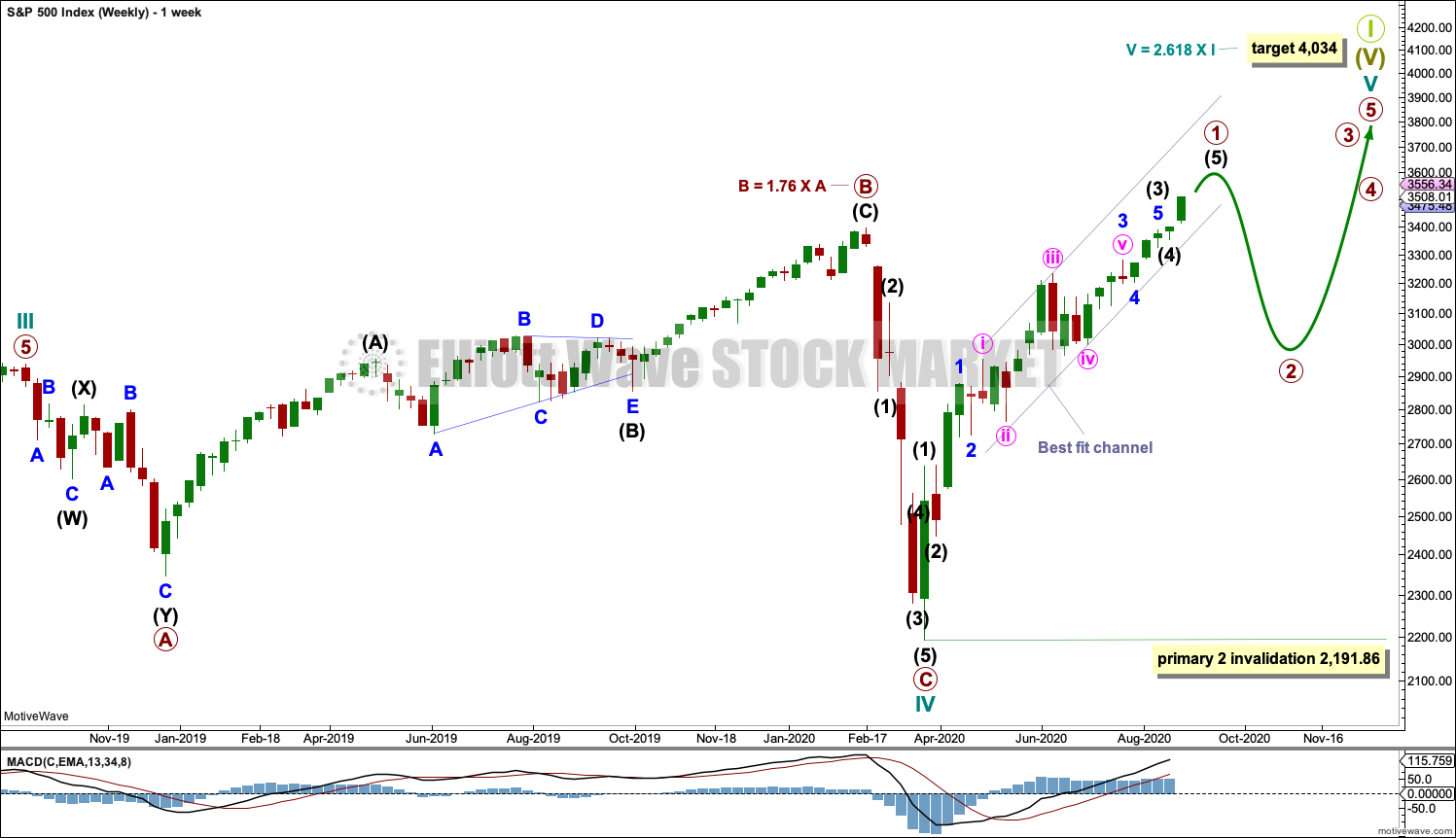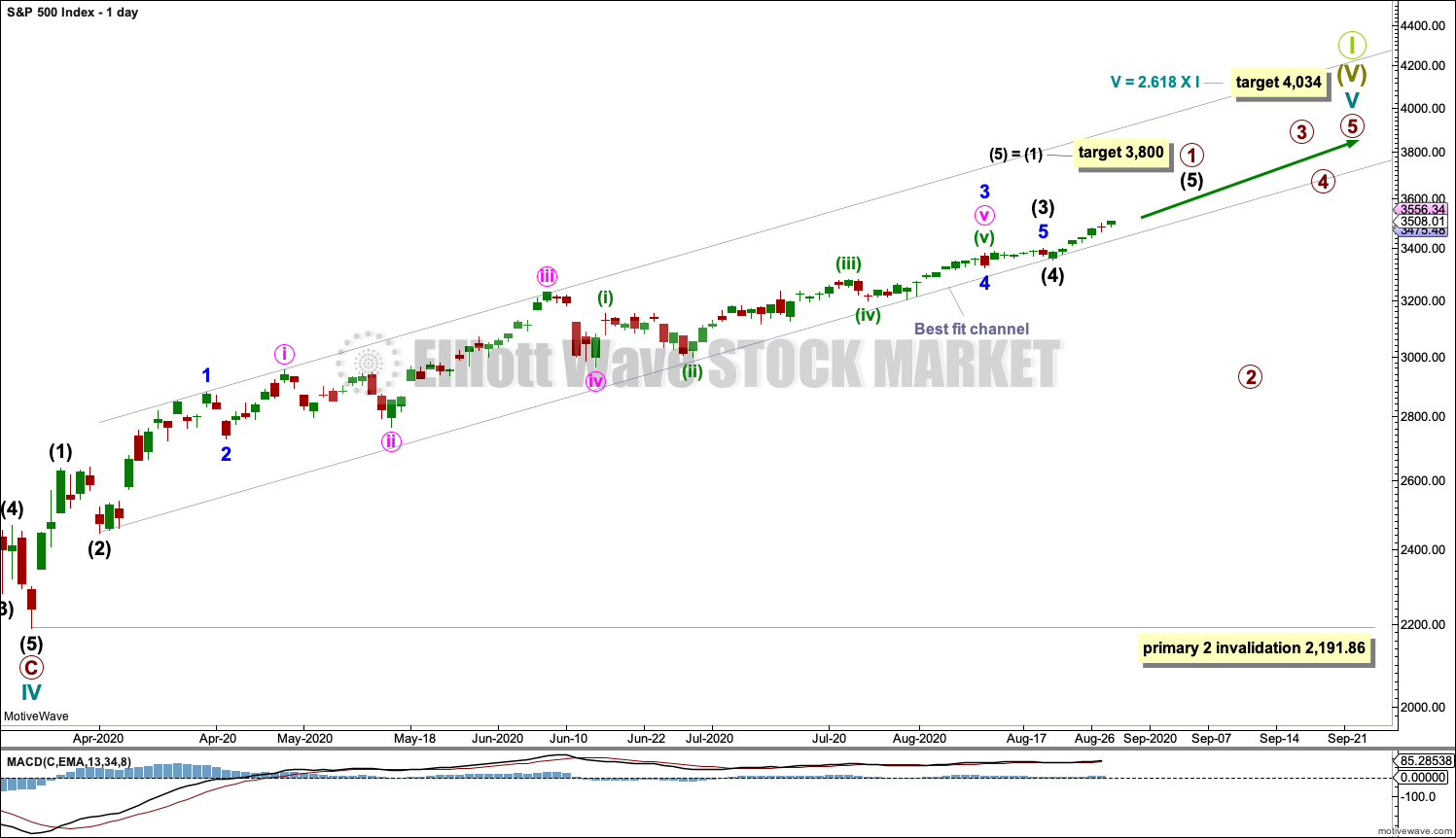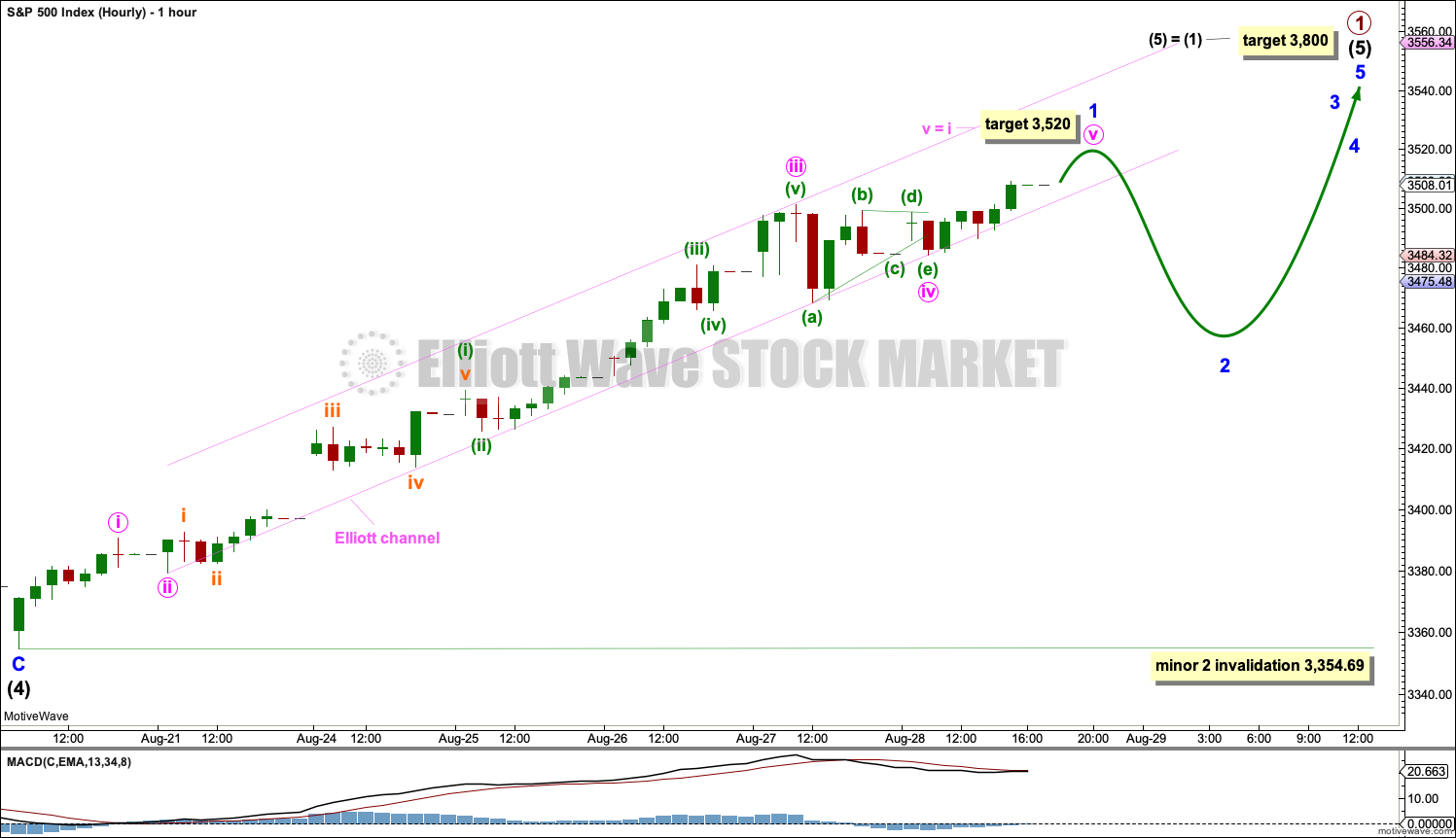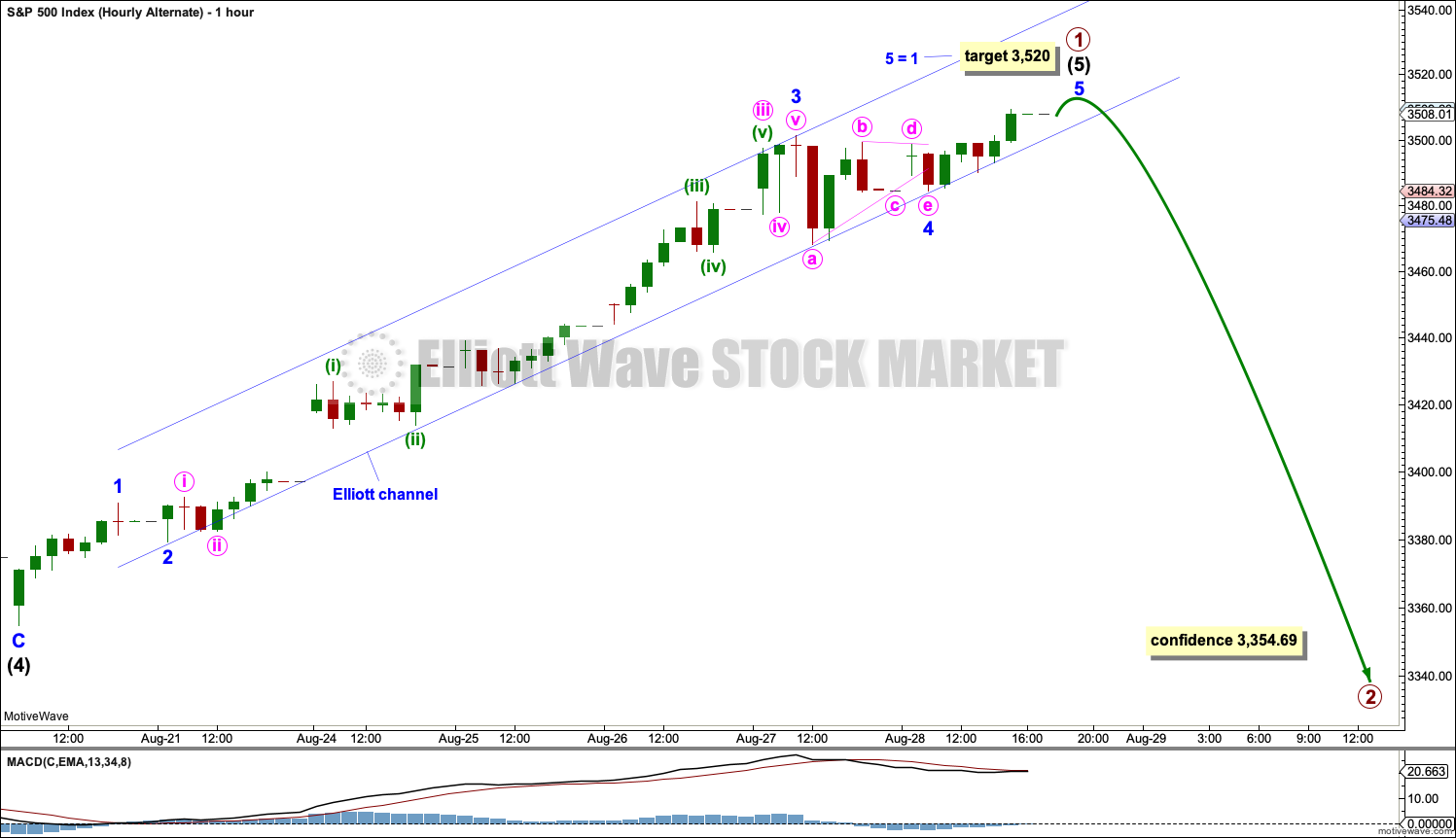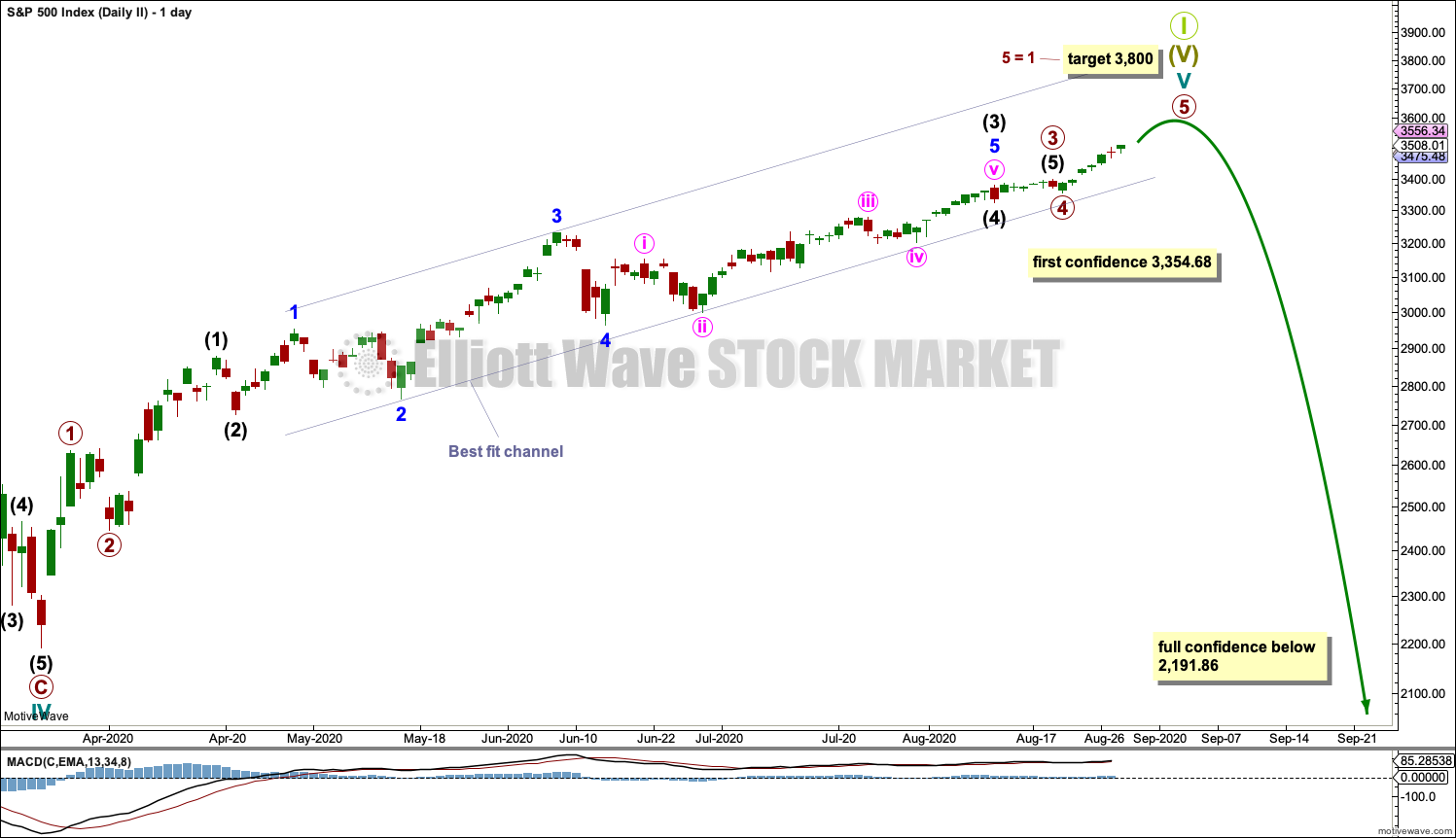S&P 500: Elliott Wave and Technical Analysis | Charts – August 28, 2020
Upwards movement continues. The final target remains the same at the end of this week.
Breadth and volatility are sounding increasingly strong warnings.
Summary: A target for upwards movement to end is at 3,800.
For the short term, a pullback or consolidation may begin about 3,520. The bearish alternate (second wave count, daily alternate chart) considers the possibility that a huge trend change may happen about 3,520.
There is now a strong cluster of bearish divergence between price and the AD line, and price and VIX. With RSI now extreme, the warning that a large bearish move may be closer is getting louder. Risk management is extremely important in this type of environment. It is looking now like a blow off top or bubble may be forming. Either alternate wave count may outline this possibility.
Confidence points for downwards movement are 3,354.68 and 2,637.01. Further confidence in a sustainable high may be had as each price point is passed.
A new low below 2,191.86 would be extremely bearish.
The biggest picture, Grand Super Cycle analysis, is here.
Monthly charts are here, with video here.
ELLIOTT WAVE COUNTS
FIRST WAVE COUNT
WEEKLY CHART
Cycle wave V may last from one to several years. So far it has lasted 5 months.
Cycle wave V would most likely subdivide as an impulse. But if overlapping develops, then an ending diagonal should be considered. This chart considers the more common impulse.
Primary wave 1 may be incomplete. Primary wave 2 may not move beyond the start of primary wave 1 below 2,191.86.
There is already a Fibonacci ratio between cycle waves I and III within Super Cycle wave (V). The S&P500 often exhibits a Fibonacci ratio between two of its actionary waves but rarely between all three; it is less likely that cycle wave V would exhibit a Fibonacci ratio. The target for Super Cycle wave (V) to end would best be calculated at primary degree, but that cannot be done until all of primary waves 1, 2, 3 and 4 are complete. The target at 4,034 is provisional, so it may change.
DAILY CHART
A target is calculated for intermediate wave (5) to complete primary wave 1, based upon the most common Fibonacci ratio to intermediate wave (1).
The best fit channel contains all of primary wave 1.
When this best fit channel is breached by a full daily candlestick below and not touching the lower edge, then that may be taken as an indication that primary wave 1 may be over and primary wave 2 may have begun.
HOURLY CHART
Intermediate wave (5) must subdivide as a five wave motive structure, most likely an impulse. Minor wave 1 within intermediate wave (5) may be incomplete. A new target is calculated for minor wave 1 to end.
Minor wave 2 may be a brief pullback within the ongoing upwards trend. The first second wave correction within a new trend for the S&P500 is not always very deep.
Minor wave 2 may not move beyond the start of minor wave 1 below 3,354.69.
ALTERNATE HOURLY CHART
By simply moving the degree of labelling within intermediate wave (5) up one degree, it is possible that primary wave 1 may be almost complete.
Primary wave 2 should last at least a few days to a couple of weeks or so. When primary wave 1 may again be complete, then a Fibonacci retracement may be drawn along the length of primary wave 1 and the 0.382 and 0.618 Fibonacci ratios may be used as targets. Primary wave 2 may not move beyond the start of primary wave 1 below 2,181.86.
SECOND WAVE COUNT
DAILY CHART
This wave count is the same as the first wave count with the exception of the degree of labelling within cycle wave V. If the degree of labelling is moved up one degree, then it is possible that cycle wave V to end Super cycle wave (V) to end Grand Super Cycle wave I is very close to completion.
Primary waves 1 through to 4 within cycle wave V may be complete. Primary wave 5 may be almost complete.
A new low below 3,354.68 would indicate at least a short-term trend change.
A new low below 2,191.86 would add full confidence in this wave count. At that stage, the first wave count would be invalidated.
HOURLY CHART
At the hourly chart level, this wave count is essentially the same as the first wave count with the main exception being the degree of labelling. Here, the degree of labelling is one degree higher.
Intermediate wave (2) may not move beyond the start of intermediate wave (1) below 3,354.69.
ALTERNATE HOURLY CHART
If the degree of labelling within primary wave 5 is moved up one degree, then it is possible that a Grand Super Cycle degree trend change may be very close.
TECHNICAL ANALYSIS
WEEKLY CHART
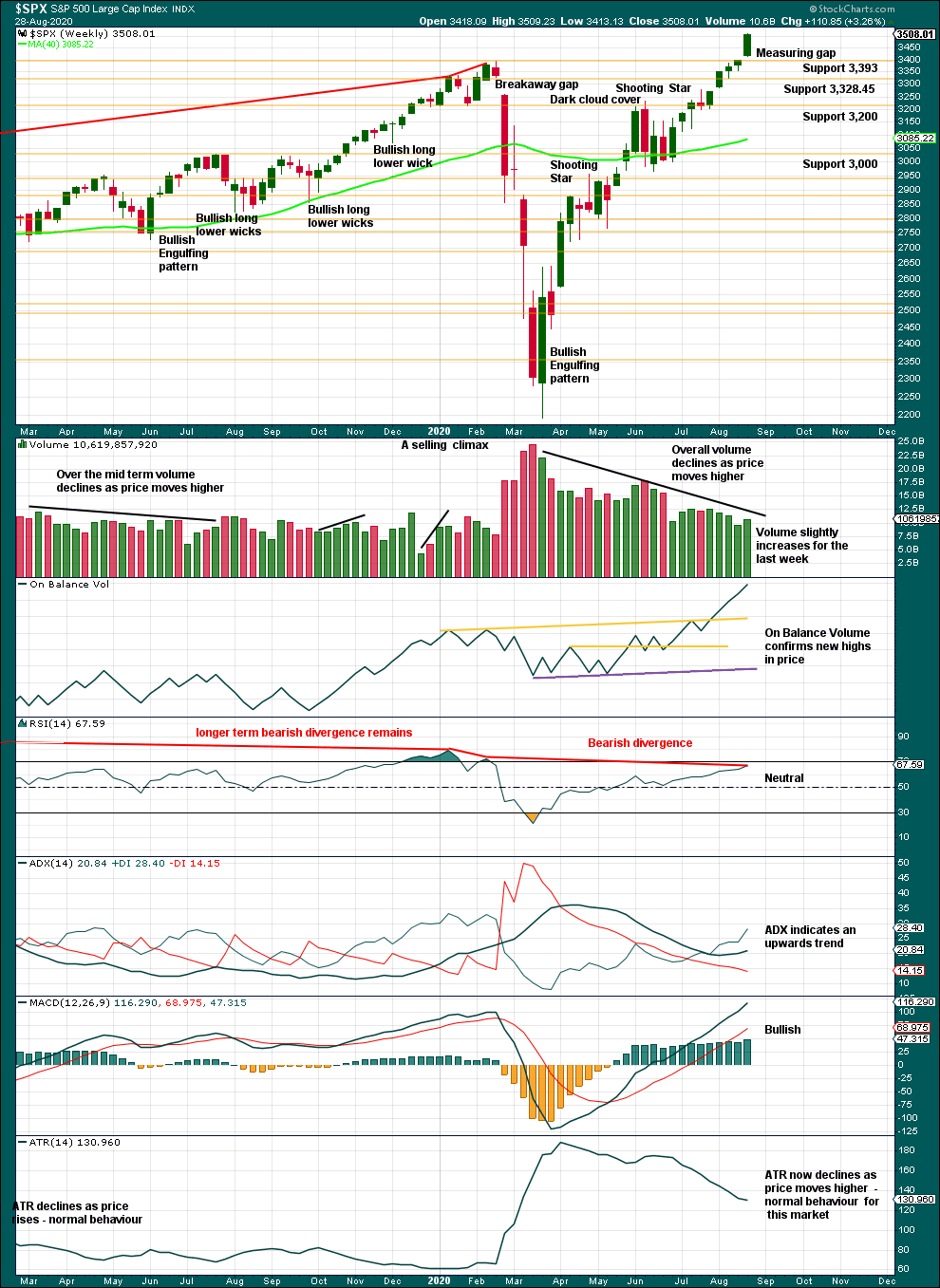
Click chart to enlarge. Chart courtesy of StockCharts.com.
The measuring gap gives a target calculation at 3,813.35.
ADX is not extreme. RSI is not overbought. There is room for this upwards trend to continue.
However, there remains weakness in longer-term bearish divergence between price and RSI.
DAILY CHART
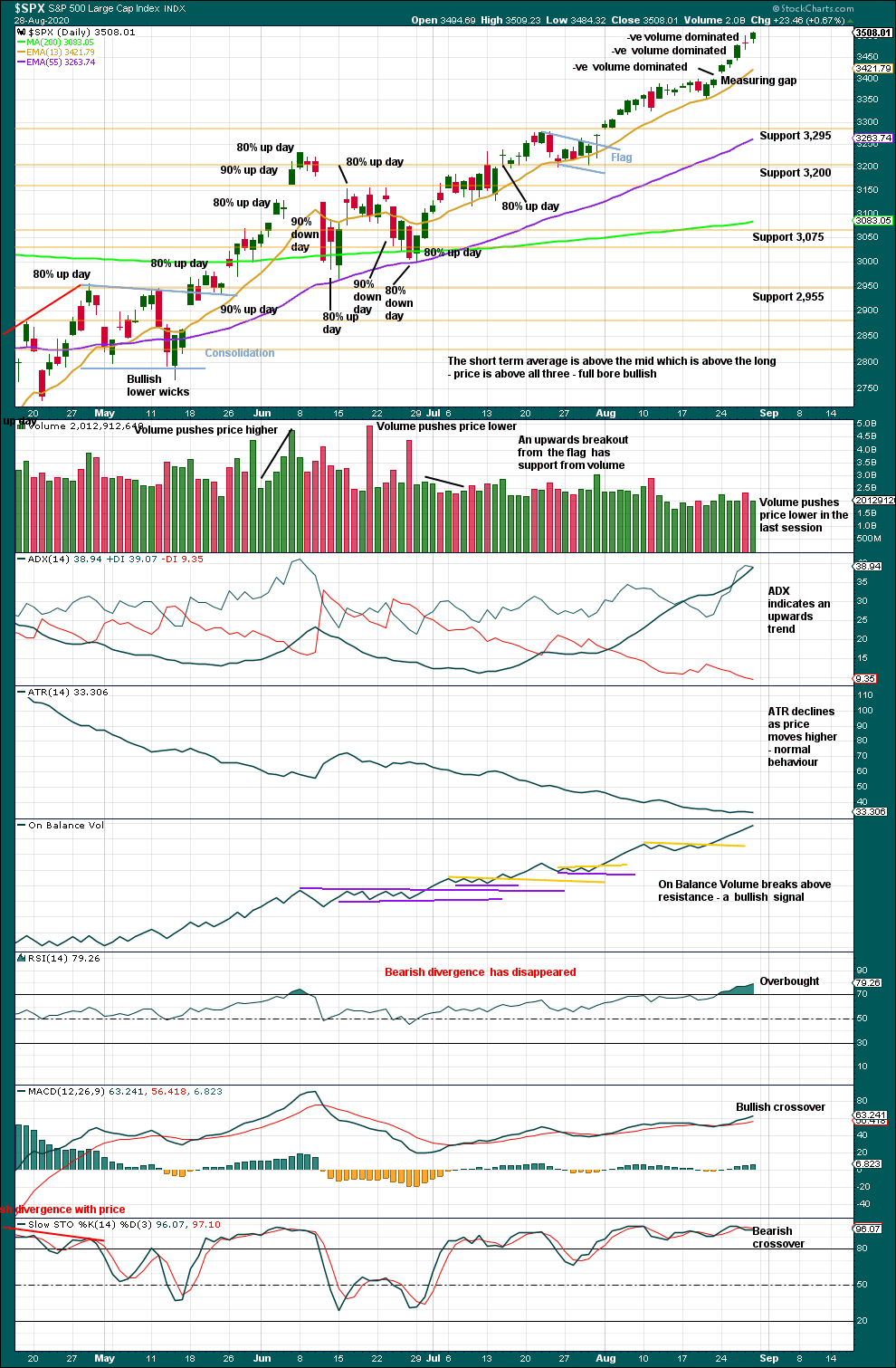
Click chart to enlarge. Chart courtesy of StockCharts.com.
Assume the trend remains the same, upwards, until proven otherwise.
However, bearish warnings are becoming louder. RSI is reaching more deeply overbought. 3 of the last 6 upwards days exhibit negative volume dominating total up / down volume. The upwards slope is increasing; a blow off top may possibly be forming. These are usually followed by sharp reversals. Risk of a sharp pullback or a trend change is increasing.
BREADTH – AD LINE
WEEKLY CHART
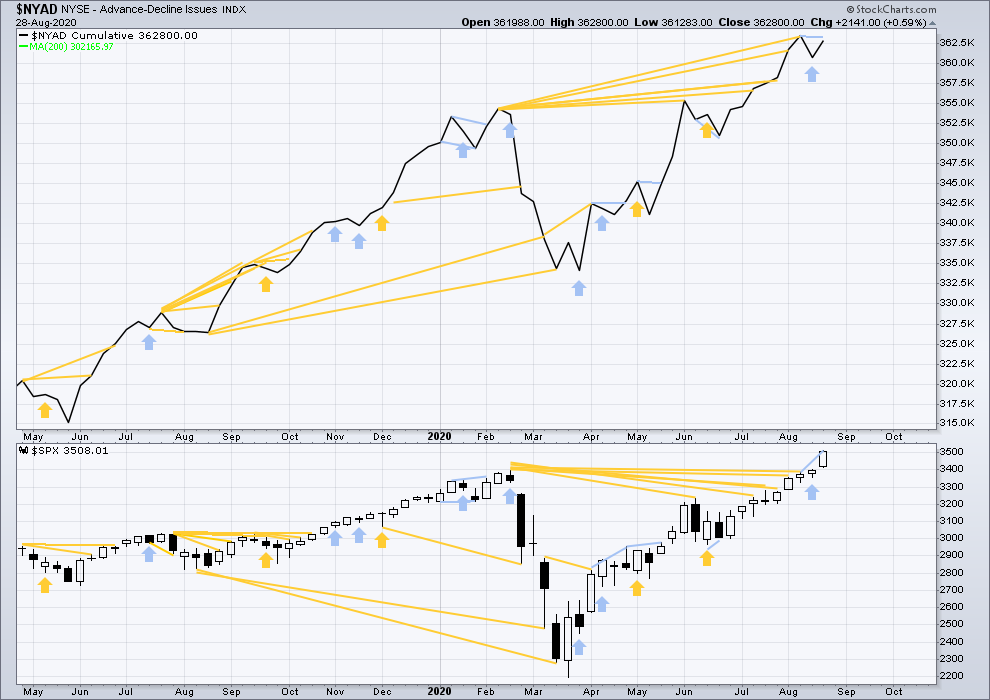
Click chart to enlarge. Chart courtesy of StockCharts.com. So that colour blind members are included, bearish signals will be noted with blue and bullish signals with yellow.
Breadth should be read as a leading indicator.
Lowry’s Operating Companies Only AD line has still not made new all time highs. The last high for the OCO AD line was in the week beginning January 13, 2020. There is now 7 and a half months of bearish divergence between price and the OCO AD line. This may now support the more bearish second wave count. It is possible now that a major trend change may occur.
The NYSE All Issues AD line made new highs in the week beginning 1st of June.
This week both price and the AD line have moved higher, but while price has made a new high the AD line has not. This divergence is bearish for the short term.
Large caps all time high: 3,509.23 on 28th August 2020.
Mid caps all time high: 2,109.43 on 20th February 2020.
Small caps all time high: 1,100.58 on 27th August 2018.
Again, this week only large caps made new all time highs. This rise is led by large caps, which is a feature of an aged bull market.
DAILY CHART
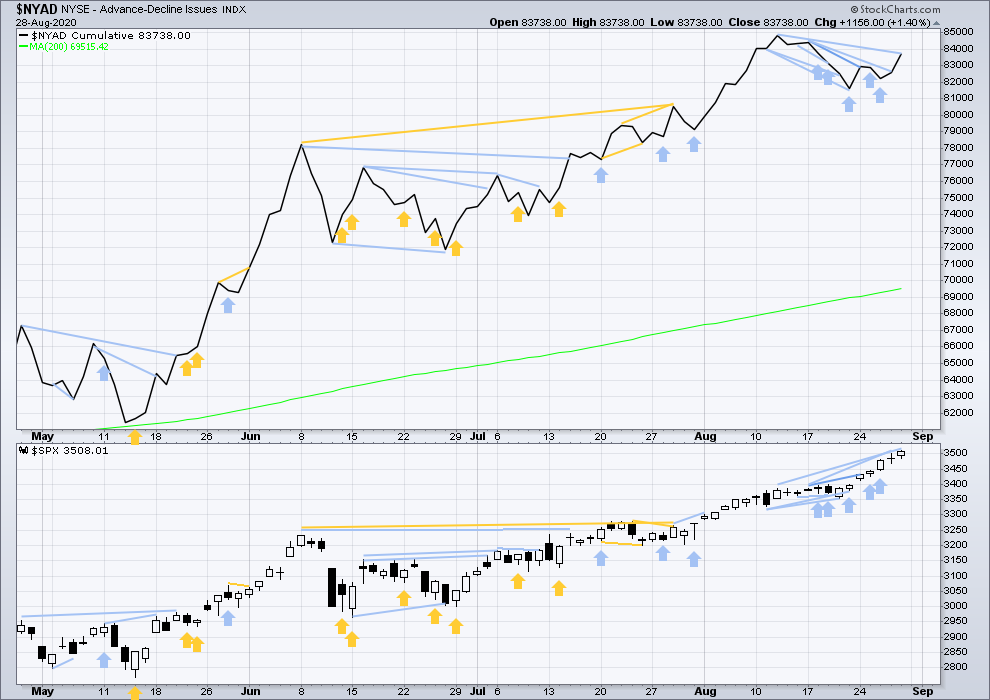
Click chart to enlarge. Chart courtesy of StockCharts.com. So that colour blind members are included, bearish signals will be noted with blue and bullish signals with yellow.
Again, today price has made another new all time high, but the AD line has not. This divergence is bearish.
There is now a fairly strong cluster of bearish signals now from the AD line, a multi-week pullback may now be very close.
VOLATILITY – INVERTED VIX CHART
WEEKLY CHART
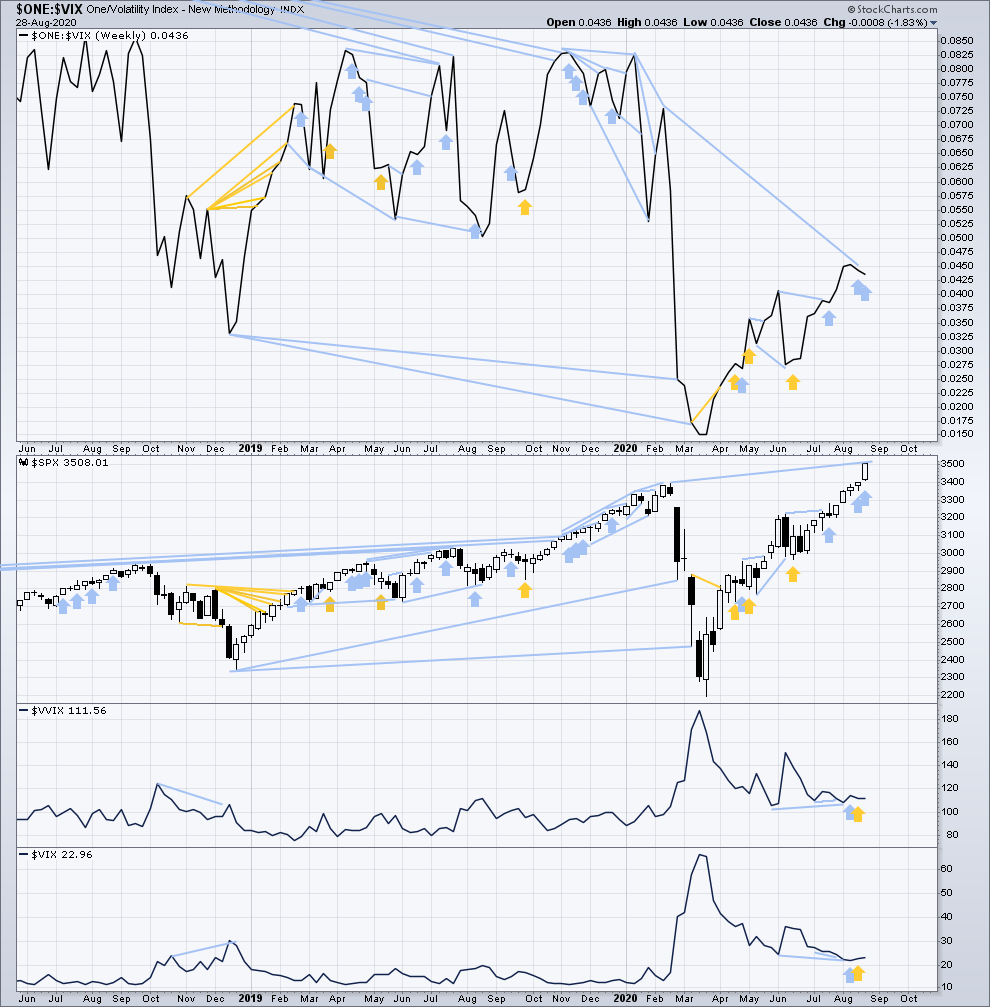
Click chart to enlarge. Chart courtesy of StockCharts.com. So that colour blind members are included, bearish signals will be noted with blue and bullish signals with yellow.
Inverted VIX remains well below all time highs. The all time high for inverted VIX was in the week beginning October 30, 2017. There is nearly 3 years of bearish divergence between price and inverted VIX. There is all of long, mid and short-term bearish divergence.
Price has moved higher for the last two weeks, but inverted VIX has moved lower. This divergence is bearish.
Comparing VIX and VVIX: From weeks beginning 1st June to two weeks ago, VIX has made new lows as price has made new highs, but VVIX has failed to make corresponding new lows with VIX. VVIX remains slightly elevated. This divergence is not strong, but it is bearish for price.
DAILY CHART
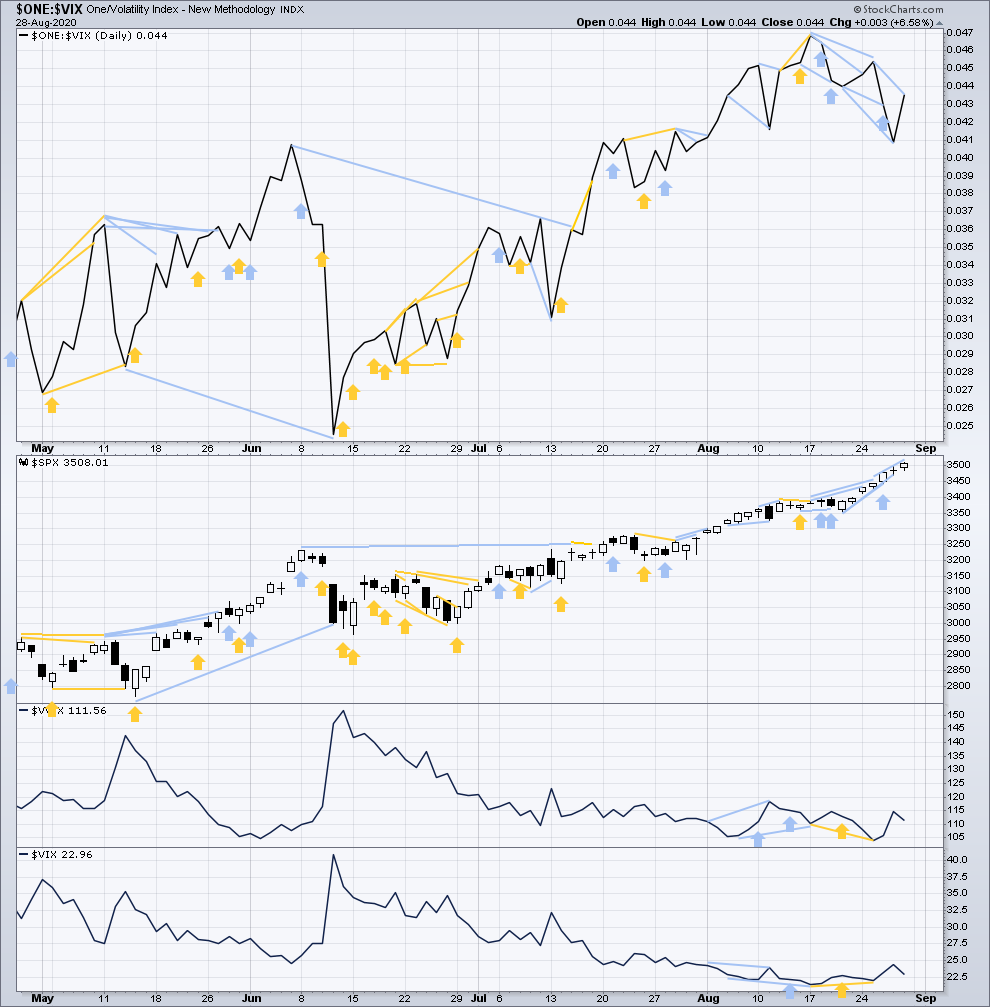
Click chart to enlarge. Chart courtesy of StockCharts.com. So that colour blind members are included, bearish signals will be noted with blue and bullish signals with yellow.
Price has moved higher to make a new all time high, but inverted VIX has failed to make a new short-term high. This divergence is bearish.
Comparing VIX and VVIX at the daily chart level: Both remain elevated. This is bearish for price.
DOW THEORY
Dow Theory still concludes a bear market is in place.
Dow Theory confirmed a bear market with the following lows made on a closing basis:
DJIA: 21,712.53 – a close below this point was been made on the March 12, 2020.
DJT: 8,636.79 – a close below this point was been made on March 9, 2020.
Adding in the S&P and Nasdaq for an extended Dow Theory, a bear market was confirmed:
S&P500: 2,346.58 – a close below this point was made on March 20, 2020.
Nasdaq: 7,292.22 – a close below this point was made on the March 12, 2020.
At this time, to shift Dow Theory from viewing a bear market to confirmation of a new bull market would require new highs made on a closing basis:
DJIA: 29,568.57
DJT: 11,623.58
Adding in the S&P and Nasdaq for an extended Dow Theory, confirmation of a bull market would require new highs made on a closing basis:
S&P500: 3,393.52 – closed above on 21st August 2020.
Nasdaq: 9,838.37 – closed above on June 8, 2020.
Published @ 07:27 p.m. ET
—
Careful risk management protects your trading account(s).
Follow my two Golden Rules:
1. Always trade with stops.
2. Risk only 1-5% of equity on any one trade.
—
New updates to this analysis are in bold.

